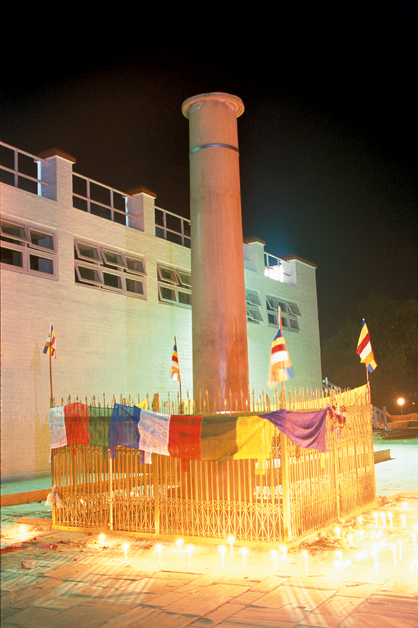Around the world, there is a consensus that there are only two things certain in life: death and taxes.In Nepal, each year, as the monsoon rains begin, there are numerous meetings and endless debates surrounding taxes and the new budget. Today the government does not seem to raise enough taxes to sustain itself, let alone do all the things demanded of them. Believe it or not, Nepalis have always had to put up with taxes.
 One of the oldest and clearly stated tax policies found in Nepal can be seen on the stone pillar erected by Mauryan Emperor Ashoka at Lumbini to mark the spot where Siddhartha – the Buddha was born. Translation of the Brahmi script done by many historians over the last century since the re-discovery of the pillar in 1896, tells us that Ashoka decided to tax the village of Lumbini (Lummini gamme) only one eighth of their agricultural produce. This may be the reason why the pillar, the Mayadevi temple and surrounding archeological remains have been spared total destruction to this day. We know the exact location of the birth of the Buddha simply because Ashoka provided local people a tax incentive and wrote it on stone.
One of the oldest and clearly stated tax policies found in Nepal can be seen on the stone pillar erected by Mauryan Emperor Ashoka at Lumbini to mark the spot where Siddhartha – the Buddha was born. Translation of the Brahmi script done by many historians over the last century since the re-discovery of the pillar in 1896, tells us that Ashoka decided to tax the village of Lumbini (Lummini gamme) only one eighth of their agricultural produce. This may be the reason why the pillar, the Mayadevi temple and surrounding archeological remains have been spared total destruction to this day. We know the exact location of the birth of the Buddha simply because Ashoka provided local people a tax incentive and wrote it on stone.
As for what tax policies need to be adopted in the best interest of the people, we can draw insights from the famous Mauryan period teacher and statesman Chanakya who is said to have authored some of the earliest policies on taxation systems and economic policies over two thousand years ago. He explained that when clothes are put out to dry in the sun, towels for example will give off more moisture than a thin sheet. When it rains, regardless of how much water the cloth gave up, it rains equally on all. The rich pay more and the poor pay less but the benefit of the state expenditure on public works undertaken would benefit everyone equally. Something we need to put into practice even today.
During the reign of the Lichavis in Nepal from the 2nd to 7th century, land tax was the principle source of state revenue. Such taxes ranged from as much as 50% to as low as 5% depending on the soil type and yield of the land. Livestock provided the second largest source of revenue. While there are descriptions of trade and taxes in Nepal from the very early periods, it seems that after the twelfth century, the trade between the Gangetic plains and Tibet through the Kathmandu valley was systematically taxed and the revenue directed to building the numerous palaces, temples and public works that we see all over the valley today. According to records kept by the Jesuits, during the Malla period, every “pay load” on humans or animals was taxed nine “Mahindra Malli”. (This was the name of the locally minted currency used in the trade). If the porter did not bring back a load of salt from Tibet, the fine was one Mahindra Malli (MM). If “foreigners” wanted to export the same goods to Tibet, the tax was 15 MM. The visa tax for Nepalis was two and half MM whereas Europeans had to pay 50 MM for the same. Now we understand how far back taxes differed for locals and foreigners in Nepal.
The monsoon or the Nepali months of Asar and Shrawan is a period when we experience traffic jams everywhere because the normally dormant department of roads wakes up and springs into action digging streets and patching them up everywhere. Everyone is aware that the new fiscal year is upon us and somehow we have to spend the allocated resources before the new budget is announced. Where is the correlation? Why does Nepal’s fiscal year begin in mid-July and not in April as in Japan; nor in November as in the USA? History teaches us that the Nepali state has always levied an annual tax on the Nepali people called “shrawanka” in the Licchavi period, “shagon” in the Malla period and “sawane” in the Shah period. The new tax year therefore has always started in the month of Shrawan, which falls on July 17 this year and ends in Asar. Old habits die hard.
During the reign of Jung Bahadur Rana, the tax system for west Nepal and the rest of Nepal was different. According to Shreeram Prasad Upadyaya, on the western frontier of Nepal, the government imposed high export duties on Nepali traders and light import duties on Indian traders. It was done to provide incentive to traders to inhabit and promote trade in the under developed and sparsely populated regions of the west. Trade of any kind of food was tax free in west Nepal as well. Why can’t we learn and do the same for the less affluent areas of Nepal today?
Anil Chitrakar is a founding member of Kathmandu 2020 and
has launched Crafted in Kathmandu to help local artisans.
For comments e-mail: rosha@craftedinkathmandu.com











